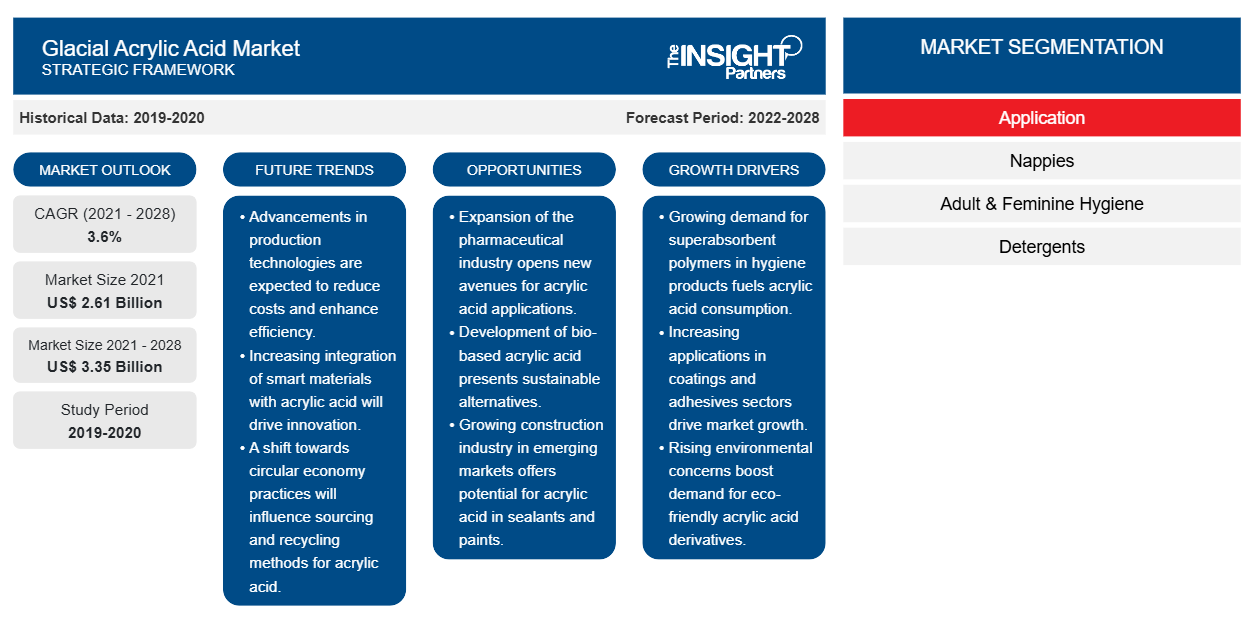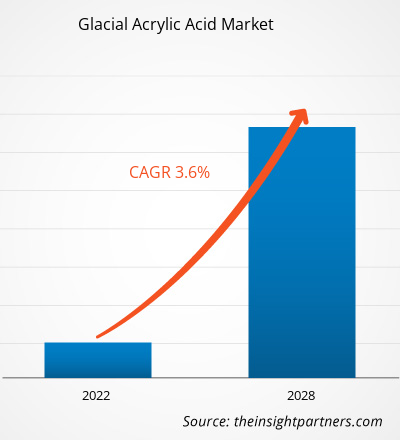The glacial acrylic acid market was valued at US$ 2,607.67 million in 2021 and is projected to reach US$ 3,351.24 million by 2028; it is expected to grow at a CAGR of 3.6% from 2021 to 2028.
Glacial acrylic acid is an unsaturated carboxylic acid co-monomer. It readily copolymerizes with acrylic and methacrylic esters, ethylene, vinyl acetate, styrene, butadiene, acrylonitrile, vinyl chloride, maleic esters, and vinylidene chloride. Glacial acrylic acid is majorly used as a building block for the production of acid-functional and crosslinked acrylic copolymers and polyacrylic acids. Glacial acrylic acid offers notable advantages as a co-monomer in an extensive range of acrylic and vinyl acrylic polymer-based finishes, coatings, sealants, adhesives, inks, thickeners, flocculants, and lubricants, among others. Besides, GAA is used to make polymers utilized in applications ranging from medical hydrogels to superabsorbent polymers to detergents.
Asia-Pacific accounted for the largest share of the global glacial acrylic acid market during the forecast period. The increasing demand for baby diapers in emerging nations such as South Korea and China has contributed to the demand for superabsorbent polymers (SAPs). Moreover, glacial acrylic acid finds multiple applications in adhesives, paints, construction, water treatment, detergents, leather treatments, and textile chemicals, among others. Consequently, these factors have led to the glacial acrylic acid market growth in the region.
The ongoing COVID-19 pandemic has drastically altered the status of the glacial acrylic acid market and has negatively impacted its growth. The outbreak has declined operational efficiency and interrupted the value chains, owing to the sudden closure of national and international boundaries, thereby creating revenue loss and damage. The disruptions in value chain have restricted the supply of raw material, which, in turn, is hindering the growth of the market and affecting the development of the end-use industries. However, as the economies are planning to revive their operations, the demand for glacial acrylic acid is expected to rise globally in coming months. With the growing consciousness toward sustainability and diversification of application bases in post-pandemic times, the demand for glacial acrylic acid is expected to take huge leaps in the future. According to International Finance Corporation, the COVID-19 outbreak is forecasted to slow down investments in the water sector globally. A survey by Global Water Leaders Group predicted that industrial water demand will fall by approximately 27% due to the outbreak. Further, the Global Water Leaders Group stated that water and wastewater utilities worldwide are expected to see revenue collection reductions of 15% on average due to the COVID-19 crisis. Thus, the water sector is anticipated to witness decline in the demand for water treatment chemicals, which would negatively impact the glacial acrylic acid market. Nevertheless, effective measures taken by associations—such as Industrial Fabrics Association International—backed by positive government initiatives to safeguard their frontline health care workers are expected to boost the textile industry, which would bolster the demand for glacial acrylic acid in coming years.
Customize This Report To Suit Your Requirement
You will get customization on any report - free of charge - including parts of this report, or country-level analysis, Excel Data pack, as well as avail great offers and discounts for start-ups & universities
Glacial Acrylic Acid Market: Strategic Insights

-
Get Top Key Market Trends of this report.This FREE sample will include data analysis, ranging from market trends to estimates and forecasts.
Market Insights
Increasing Use of Superabsorbent Polymers in Diapers and Hygiene Products
Acrylic acid accounts for 80–85% of raw materials utilized in the production of superabsorbents (SAPs). The polymer is produced by aqueous solution polymerization of glacial acrylic acid with crosslinking monomer and an initiator. Superabsorbents are extensively used in diapers and hygienic products as they can absorb and retain large volumes of water and aqueous solutions. SAPs are primarily made from partially neutralized and lightly crosslinked polyacrylic acids and are the indispensable constituents in feminine hygiene, disposable diapers, as well as adult incontinence products. Approximately 77.5% of the global SAP is utilized in diapers, 9.5% in adult incontinence products, and 4% in feminine hygiene. SAPs are vital products in the acrylic acid value chain, and their water-absorbing attributes are increasing their demand in sanitary and hygiene products. Furthermore, the key manufacturers are focusing on the production of acrylic acid and its derivative products, such as acrylates and superabsorbent polymers. For instance, NIPPON SHOKUBAI CO., LTD has been expanding its core businesses in superabsorbent polymers and acrylic acid across the world. With their surging application in diapers, the company’s annual production capacity of SAPs has grown strongly, which also acts as the company’s strength. Thus, the growth of the glacial acrylic acid market is attributed to the rising demand for superabsorbent polymer production. In addition, the growing hygiene awareness among the populace, especially aging population drives the demand for glacial acrylic acid in diapers and hygiene products.
Application Insights
Based on application, the global glacial acrylic acid market is segmented into nappies; adult & feminine hygiene; detergents; adhesives, coatings & sealants; water treatment; and others. The nappies segment held the largest share of the market during the forecast period. Glacial (distilled) acrylic acid is utilized in superabsorbent polymers (SAPs) which are extensively used in disposable baby diapers. Superabsorbent polymers are cross-linked polyacrylates that absorb and retain over a hundred times their own weight in liquid. SAPs account for more than 30% of world acrylic acid consumption. Manufacturers are offering glacial acrylic acid, which finds extensive applications in nappies. BASF PETRONAS Chemicals Sdn. Bhd. offers glacial acrylic acid for disposable diapers. Further, glacial acrylic acid offered by Tasnee is an unsaturated carboxylic acid available in clear colorless liquid with a characteristic acrid odor. It is miscible with water, alcohol, and ethers. It is utilized for polymer preparation and as a chemical intermediate. Glacial acrylic acid finds applications in industries such as nappies.
The Dow Chemical Company; Arkema; BASF SE; Sasol; Tasnee; HAITUNG CHEMICALS CO., LTD.; Mitsubishi Chemical Corporation; NIPPON SHOKUBAI CO., LTD.; Formosa Plastics Corporation; and BASF PETRONAS Chemicals Sdn. Bhd are among the well-established players in the global glacial acrylic acid market. Companies in this market have been continuously focusing on strategies such as product developments, plant expansions, and mergers and acquisitions to expand their footprint worldwide and fulfill the growing demand of the market. For instance, in 2019, Arkema successfully brought a new 90,000-ton per year acrylic acid reactor at its Clear Lake, Texas site. The new reactor, which is equipped with the latest production technologies, replaces two decommissioned reactors of 45,000 tons each. The investment of approximately US$ 90 million positions Clear Lake as one of the most competitive acrylic acid sites in the US. This new capacity will enable the Group to promote the growth of its North American customers in markets such as paints and coatings, superabsorbents, adhesives, and polymers for water treatment and enhanced oil & gas recovery. In addition, this expansion consolidates Arkema’s position as the second-largest producer of acrylic acid in the region.
Glacial Acrylic Acid Market Regional InsightsThe regional trends and factors influencing the Glacial Acrylic Acid Market throughout the forecast period have been thoroughly explained by the analysts at The Insight Partners. This section also discusses Glacial Acrylic Acid Market segments and geography across North America, Europe, Asia Pacific, Middle East and Africa, and South and Central America.
Glacial Acrylic Acid Market Report Scope
| Report Attribute | Details |
|---|---|
| Market size in 2021 | US$ 2.61 Billion |
| Market Size by 2028 | US$ 3.35 Billion |
| Global CAGR (2021 - 2028) | 3.6% |
| Historical Data | 2019-2020 |
| Forecast period | 2022-2028 |
| Segments Covered |
By Application
|
| Regions and Countries Covered |
North America
|
| Market leaders and key company profiles |
|
Glacial Acrylic Acid Market Players Density: Understanding Its Impact on Business Dynamics
The Glacial Acrylic Acid Market is growing rapidly, driven by increasing end-user demand due to factors such as evolving consumer preferences, technological advancements, and greater awareness of the product's benefits. As demand rises, businesses are expanding their offerings, innovating to meet consumer needs, and capitalizing on emerging trends, which further fuels market growth.

- Get the Glacial Acrylic Acid Market top key players overview
Report Spotlights
- Progressive industry trends in the global glacial acrylic acid market to help players develop effective long-term strategies
- Business growth strategies adopted by developed and developing markets
- Quantitative analysis of the global glacial acrylic acid market from 2019 to 2028
- Estimation of the demand for glacial acrylic acid across various industries
- PEST analysis to illustrate the efficacy of buyers and suppliers operating in the industry to predict market growth
- Recent developments to understand the competitive market scenario and the demand for glacial acrylic acid
- Market trends and outlook coupled with factors driving and restraining the growth of the glacial acrylic acid market
- Decision-making process by understanding strategies that underpin commercial interest with regard to the global glacial acrylic acid market growth
- Glacial acrylic acid market size at various nodes of the market
- Detailed overview and segmentation of the global glacial acrylic acid market as well as its dynamics in the industry
- Glacial acrylic acid market size in various regions with promising growth opportunities
Glacial Acrylic Acid Market, by Application
- Nappies
- Adult & Feminine Hygiene
- Detergents
- Adhesives, Coatings & Sealants
- Water Treatment
- Others
Company Profiles
- The Dow Chemical Company
- Arkema
- BASF SE
- Sasol
- Tasnee
- HAITUNG CHEMICALS CO.,LTD.
- Mitsubishi Chemical Corporation
- NIPPON SHOKUBAI CO., LTD.
- Formosa Plastics Corporation
- BASF PETRONAS Chemicals Sdn. Bhd
Frequently Asked Questions
Based on application, why nappies segment accounted for the largest share in the global market?
Can you list some of the major players operating in the global glacial acrylic acid market?
Which region held the largest share of the global glacial acrylic acid market in 2019?
- Historical Analysis (2 Years), Base Year, Forecast (7 Years) with CAGR
- PEST and SWOT Analysis
- Market Size Value / Volume - Global, Regional, Country
- Industry and Competitive Landscape
- Excel Dataset
Recent Reports
Related Reports
Testimonials
Reason to Buy
- Informed Decision-Making
- Understanding Market Dynamics
- Competitive Analysis
- Identifying Emerging Markets
- Customer Insights
- Market Forecasts
- Risk Mitigation
- Boosting Operational Efficiency
- Strategic Planning
- Investment Justification
- Tracking Industry Innovations
- Aligning with Regulatory Trends





















 Get Free Sample For
Get Free Sample For